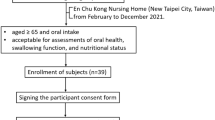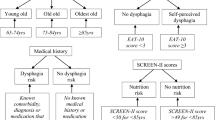Abstract
We examined factors related to dietary intake status (food form) of long-term care facility (LTCF) residents to identify factors related to proper food form choice for older individuals requiring nursing care. We surveyed 888 residents from 37 LTCFs in Japan. We evaluated basic information (age, sex, body mass index [BMI]), food form (swallowing-adjusted diet class), Barthel Index (BI), Clinical Dementia Rating (CDR), simply evaluated eating and swallowing functions, the number of present/functional teeth, oral diadochokinesis, repetitive saliva swallowing test (RSST), and modified water swallowing test. To clarify factors associated with food form, participants who had good nutrition by oral intake were categorized into the dysphagic diet (DD) and normal diet (ND) groups. Multi-level analyses were used to detect oral functions associated with food form status. Among objective assessments, BMI (odds ratio [OR] 0.979, 95% confidence interval [CI] − 0.022- to 0.006, p = 0.001), BI (OR 0.993, 95% CI − 0.007 to − 0.004, p < 0.001), CDR 3.0 (OR 1.002, 95% CI 0.002‒0.236, p = 0.046), present teeth (OR 0.993, 95% CI − 0.007 to − 0.001, p = 0.011), functional teeth (OR 0.989, 95% CI − 0.011 to − 0.005, p < 0.001), and RSST (OR 0.960, 95% CI − 0.041 to − 0.007, p = 0.006) were significantly associated with DD vs ND discrimination. Simple evaluations of coughing (OR 1.056, 0.054‒0.198, p = 0.001) and rinsing (OR 1.010, 0.010‒0.174, p = 0.029) could also discriminate food form status. These simple evaluations provide insight into the discrepancies between food form status and eating abilities of LTCF residents. Periodic evaluations by the nursing caregiver may help to prevent aspiration by older individuals with dysphagia.

Similar content being viewed by others
Data Availability
The data presented in this study are available on request from the corresponding author. The data are not publicly available due to ethico-legal restrictions imposed by the Ethics Committee at the Japanese Society of Gerodontology.
References
Kawashima K, Motohashi Y, Fujishima I. Prevalence of dysphagia among community-dwelling elderly individuals as estimated using a questionnaire for dysphagia screening. Dysphagia. 2004;19:266–71. https://doi.org/10.1007/s00455-004-0013-6.
Wakabayashi H, Sakuma K. Rehabilitation nutrition for sarcopenia with disability: a combination of both rehabilitation and nutrition care management. J Cachexia Sarcopenia Muscle. 2014;5:269–77. https://doi.org/10.1007/s13539-014-0162-x.
Ott A, Senger M, Lötzbeyer T, Gefeller O, Sieber CC, Volkert D. Effects of a texture-modified, enriched, and reshaped diet on dietary intake and body weight of nursing home residents with chewing and/or swallowing problems: an enable study. J Nutr Gerontol Geriatr. 2019;38:361–76. https://doi.org/10.1080/21551197.2019.1628158.
Nagaya M, Kachi T, Yamada T, Sumi Y. Videofluorographic observations on swallowing in patients with dysphagia due to neurodegenerative diseases. Nagoya J Med Sci. 2004;67:17–23.
Liu W, Williams K, Batchelor-Murphy M, Perkhounkova Y, Hein M. Eating performance in relation to intake of solid and liquid food in nursing home residents with dementia: a secondary behavioral analysis of mealtime videos. Int J Nurs Stud. 2019;96:18–26. https://doi.org/10.1016/j.ijnurstu.2018.12.010.
Takizawa C, Gemmell E, Kenworthy J, Speyer R. A systematic review of the prevalence of oropharyngeal dysphagia in stroke, Parkinson’s disease, Alzheimer’s disease, head injury, and pneumonia. Dysphagia. 2016;31:434–41. https://doi.org/10.1007/s00455-016-9695-9.
Kocdor P, Siegel ER, Giese R, Tulunay-Ugur OE. Characteristics of dysphagia in older patients evaluated at a tertiary center. Laryngoscope. 2015;125:400–5. https://doi.org/10.1002/lary.24917.
Park WY, Lee TH, Ham NS, et al. Adding endoscopist-directed flexible endoscopic evaluation of swallowing to the videofluoroscopic swallowing study increased the detection rates of penetration, aspiration, and pharyngeal residue. Gut Liver. 2015;9:623–8. https://doi.org/10.5009/gnl14147.
Campbell-Taylor I. Oropharyngeal dysphagia in long-term care: misperceptions of treatment efficacy. J Am Med Dir Assoc. 2008;9:523–31. https://doi.org/10.1016/j.jamda.2008.06.001.
Mahoney FI, Barthel DW. Functional evaluation: the Barthel index. Md State Med J. 1965;14:61–5.
Morris JC. The Clinical Dementia Rating (CDR): current version and scoring rules. Neurology. 1993;43:2412–4. https://doi.org/10.1212/wnl.43.11.2412-a.
Matsuo K, Fujishima I. Textural changes by mastication and proper food texture for patients with oropharyngeal dysphagia. Nutrients. 2020;12:1613. https://doi.org/10.3390/nu12061613.
Watanabe E, Yamagata Y, Fujitani J, et al. The criteria of thickened liquid for dysphagia management in Japan. Dysphagia. 2018;33:26–32. https://doi.org/10.1007/s00455-017-9827-x.
Yamada A, Kanazawa M, Komagamine Y, Minakuchi S. Association between tongue and lip functions and masticatory performance in young dentate adults. J Oral Rehabil. 2015;42:833–9. https://doi.org/10.1111/joor.12319.
Tohara H, Saitoh E, Mays KA, Kuhlemeier K, Palmer JB. Three tests for predicting aspiration without videofluorography. Dysphagia. 2003;18:126–34. https://doi.org/10.1007/s00455-002-0095-y.
Zenner PM, Losinski DS, Mills RH. Using cervical auscultation in the clinical dysphagia examination in long-term care. Dysphagia. 1995;10:27–31. https://doi.org/10.1007/BF00261276.
Persson E, Wårdh I, Östberg P. Repetitive saliva swallowing test: norms, clinical relevance and the impact of saliva secretion. Dysphagia. 2019;34:271–8. https://doi.org/10.1007/s00455-018-9937-0.
Suzuki R, Kikutani T, Yoshida M, Yamashita Y, Hirayama Y. Prognosis-related factors concerning oral and general conditions for homebound older adults in Japan. Geriatr Gerontol Int. 2015;15:1001–6. https://doi.org/10.1111/ggi.12382.
Leopold NA, Kagel MC. Swallowing, ingestion and dysphagia: a reappraisal. Arch Phys Med Rehabil. 1983;64:371–3.
Park YH, Han HR, Oh BM, Lee J, Park JA, Yu SJ, Chang H. Prevalence and associated factors of dysphagia in nursing home residents. Geriatr Nurs. 2013;34:212–7. https://doi.org/10.1016/j.gerinurse.2013.02.014.
Sato E, Hirano H, Watanabe Y, Edahiro A, Sato K, Yamane G, Katakura A. Detecting signs of dysphagia in patients with Alzheimer’s disease with oral feeding in daily life. Geriatr Gerontol Int. 2014;14:549–55. https://doi.org/10.1111/ggi.12131.
Dziewas R, Auf dem Brinke M, Birkmann U, et al. Safety and clinical impact of FEES—results of the FEES-registry. Neurol Res Pract. 2019. https://doi.org/10.1186/s42466-019-0021-5.
Leder SB, Murray JT. Fiberoptic endoscopic evaluation of swallowing. Phys Med Rehabil Clin N Am. 2008;19:787–801. https://doi.org/10.1016/j.pmr.2008.05.003.
Martin-Harris B, Jones B. The videofluorographic swallowing study. Phys Med Rehabil Clin N Am. 2008;19:769–85. https://doi.org/10.1016/j.pmr.2008.06.004.
Gilmore-Bykovskyi AL, Rogus-Pulia N. Temporal associations between caregiving approach, behavioral symptoms and observable indicators of aspiration in nursing home residents with Dementia. J Nutr Health Aging. 2018;22:400–6. https://doi.org/10.1007/s12603-017-0943-y.
Hoshino D, Watanabe Y, Edahiro A, et al. Association between simple evaluation of eating and swallowing function and mortality among patients with advanced dementia in nursing homes: 1-year prospective cohort study. Arch Gerontol Geriatr. 2020;87:103969. https://doi.org/10.1016/j.archger.2019.103969.
Easterling CS, Robbins E. Dementia and dysphagia. Geriatr Nurs. 2008;29:275–85. https://doi.org/10.1016/j.gerinurse.2007.10.015.
Edahiro A, Hirano H, Yamada R, Chiba Y, Watanabe Y. Comparative study of eating behavior in elderly patients with Alzheimer’s disease and vascular dementia: a first report. Comparison of disturbed eating behavior. Nihon Ronen Igakkai Zasshi. 2013;50:651–60. https://doi.org/10.3143/geriatrics.50.651.
Keller HH, Carrier N, Slaughter SE, et al. Prevalence and determinants of poor food intake of residents living in long-term care. J Am Med Dir Assoc. 2017;18:941–7. https://doi.org/10.1016/j.jamda.2017.05.003.
Acknowledgements
We would like to thank the members of the Special Committee of the Japanese Society for Geriatrics and Gerontology, as well as the staff members of the cooperating institutions and the older individuals requiring long-term care who had cooperated in this research. The authors would like to thank Editage (www.editage.com) for English language editing and publication support.
Funding
This work was supported by the Japan Ministry of Health, Labor and Welfare, and JSPS KAKENHI (Grant Nos. 20H03873, 20H03899).
Author information
Authors and Affiliations
Contributions
Conceptualization: MT, YW, YY, and MY; formal analysis: MT, YW, KO, MK, KT, and YY; investigation: MT, YW, KO, MK, KT, KI, JN, YO, RS, YN, JF, KA, HO, TO, TK, HS, TH, YS, MY, and YY; data curation: MT, YW, KO, MK, KT, KI, JN, YO, RS, YN, JF, HO, TO, TK, HS, TH, and MY; writing—original draft preparation: MT, YW, and YY; writing—review and editing: MT, YW, KO, MK, KT, KI, JN, YO, RS, YN, JF, KA, HO, TO, TK, HS, TH, YS, MY, and YY; supervision: YS, MY, and YY; project administration: YW, KO, JN, RS, KA, MY, and YY; funding acquisition: YW, MY, and YS. All authors have read and agreed to the published version of the manuscript.
Corresponding author
Ethics declarations
Conflict of interest
The authors declare no conflict of interest.
Ethical Approval
This study was conducted with approval of the Ethics Committee of the Japanese Society of Gerodontology (2018–1) and the Ethics Committee of the Graduate School of Dentistry, Hokkaido University (No. 2020–4).
Informed Consent
Written informed consent was obtained from patients and their families.
Additional information
Publisher's Note
Springer Nature remains neutral with regard to jurisdictional claims in published maps and institutional affiliations.
Rights and permissions
About this article
Cite this article
Takeda, M., Okada, K., Kondo, M. et al. Factors Associated with Food Form in Long-Term Care Insurance Facilities. Dysphagia 37, 1757–1768 (2022). https://doi.org/10.1007/s00455-022-10440-6
Received:
Accepted:
Published:
Issue Date:
DOI: https://doi.org/10.1007/s00455-022-10440-6




